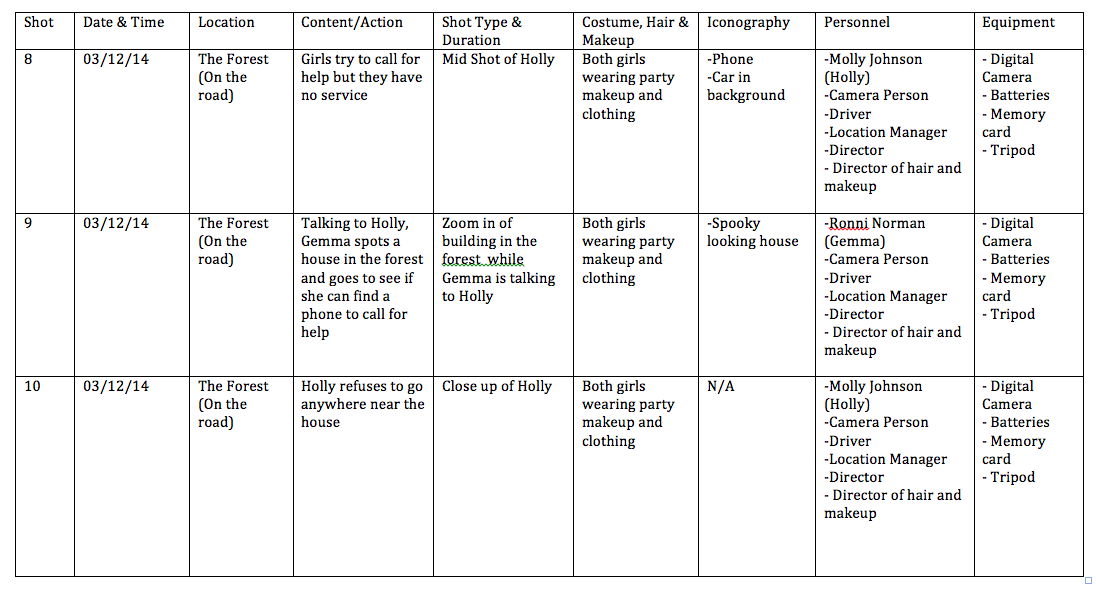Production
Introduction
People as apart of the production team need specific roles as other wise if all the roles were left to the Director then there would be too much of them to do and it would effect the way the film comes out. The roles that are assigned need to be specific for that person because its no use having the Director of Cinematography being someone who can't use a camera. It is best that there is on person for each specific role because then they can produce what they need to to there best ability for instance being just the Hair and make up designer and co ordinator then they will have there full focus on the design of that and it will look good within our opening sequence.
Director: Elizabeth Lawrie (Myself)
I volunteered myself for the role of Director as I enjoy the role of organising everyone and showing people how to do things. I think I was good at this role because when we were filming I had to quickly arrange all the actors into the scenes and made sure that they were in the right place for the frames so that we could get on with them quickly instead of wasting time arguing and make sure chloe was positioned in the right place for filming.
Actors: Amy Durrance , Molly Johnson and James Myers
As a group we decided it would be convenient to ask Amy Durrance to play the role of Gemma (the first victim) as Gemma is depicted as being blonde and coincidently Amy is a blonde, she was happy to take part in our thriller opening sequence, was free on days of filming and attended an expressive arts school so was experienced in acting.
Molly Johnson has been chosen to play the role of Holly (Gemmas friend) as she is a natural brunette who was like amy interested in taking part of our thriller opening sequence, was free on days of filming and also attended an expressive arts school so had experience in acting.
James Myers was cast by the antagonist by our group as he is tall and....
Director of Photography: Chloe Eustace
Chloe volunteered herself for the role of Director of Photography because she had some experience in using cameras and getting a good shots, as do I. However, we decided it would be for the best if Chloe was in charge of the cinematography we didn't want to take on too many large roles per person and I already had volunteered for the role of director therefore its seemed suitable that Chloe take on this role as she has experience with using camera and had not already been given a major role. We decided as a group that it would be best for someone who knows how to use the camera to be in charge of filming as then it will be easier whilst filming because Chloe would know what and when she needs to be doing. Chloe was very good at organising the shots during filming and managed to get all the shots that we needed for the opening sequence acquired a variety of different angles for editing.
Mise-en-scene Co ordinator: Elizabeth Lawrie
We decided as a group that it would be best for myself to be in charge of mise- en-scene as I had already found the location for us to film and I was interested in organising everyone and making sure that costumes and hair are in order. As a group we decided that it would be best for me to be in charge of this as neither Chloe nor Miranda had any interest in arranging people and getting things for each shot organised.
Producer: Miranda Simpson
Music Producer: Chloe Eustace
Screen Play Writer: Miranda Simpson
Conclusion
In conclusion we decided on these roles in peoples best interest and roles that would be good for the film, we didn't want to ruin filming so we needed to make sure that each person who had a role could follow through with it other wise it might effect the outcome of our final opening sequence. During filming we took to these roles well and it made it easy then to get the shots that we need because everyone stuck to what they can do well and this caused less arguments or tension whilst filming and editing to produce our final product. We could have changed some roles around because although some people had experience with different roles we found that other people could do that role better anyway. This would have been something that we could have practised a few more times while filming practise so that we could see how people reacted within there roles before we filmed completely.















